The selection of controller (converter) depends upon the application. One of the main aspects of the research in SRM drives has been the converter design. The main objectives of the design of the converter are performance of the drive and cost of the drive.
The power semiconductor switching circuits used are
1. Two power semiconductor switching devices per phase and two diodes.
2. (n+1) power semiconductor switching devices (n+1) diodes.
3. Phase winding using bifilar wires.
4. Split-link circuit used with even-phase number.
5. C-dump circuit.
1. Two Power Semiconductor Switching Devices per phase and two diodes
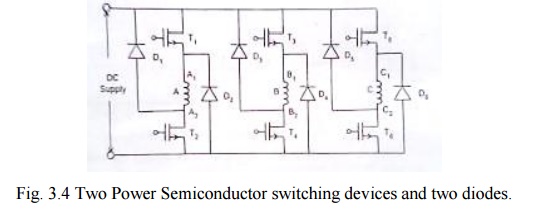
As shown in fig 3.4 phase winding A is connected to the dc supply through power semiconductor devices T1 and T2. Depending upon the rotor position, when the phase winding A is to be energized the devices T1 and T2 are turned ON. When the phase winding is to be disconnected from the supply (this instant is also dependent on the position of the shaft) the devices T1 and T2 are turned off .The stored energy in the phase winding A tends to maintain the current in the same direction. This current passes from the winding through D1 and D2 to the supply. Thus the stored energy is fed back to the mains.
Similarly phase winding B & C are also switched on to the supply and switched off from the supply in a cyclic manner. This circuit requires 2 power switching devices and 2 diodes for each phase winding. For high speed operation it is required to see that the stored energy can be fed back to the mains within the available period.
Usually the upper devices T1, T3 and T5 are turned on and off from the signals obtained from the rotor position sensor .The duration of conduction or angle of conduction θ can be controlled by using suitable control circuitry .The lower devices T2, T4, T6 are controlled from signals obtained by chopping frequency signal. The current in the phase winding is the result of logical AND ing of the rotor position sensor and chopping frequency .As a result it is possible to vary the effective phase current from a very low value to a high value .For varying the following methods are available.
1. By varying the duty cycle of the chopper.
2. By varying the conduction angle of the devices.
Merits
v Control of each phase is completely independent of the other phase.
v The converter is able to free wheel during the chopping period at low speeds which helps to reduce the reduce the switching frequency and thus the switching losses of the converter.
v The energy from the off going phase is feedback to the source, which results in utilization of energy
Demerits
v Higher number of switches required in each phase, which makes the converter expensive and also used for low voltage applications.
2. (n+1) power switching devices and (n+1) diodes
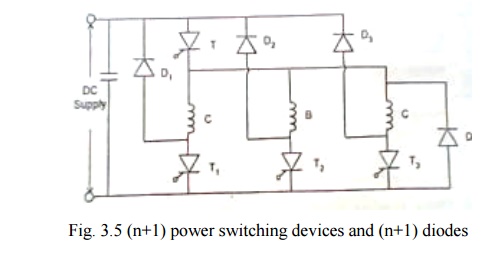
This circuit makes use of less number of power switching devices and diodes as shown in fig 3.5. When the (SCRs) switching devices T and T1 are turned on phase winding A is energized from the dc supply. When these devices are turned off the stored energy in the phase winding is fed back to the mains through diodes D and D1. When devices T and T2 are turned on the phase winding B is energized .When they are turned off ,the stored energy in B phase winding C is switched on and off from the mains. The cycle gets repeated.
This circuit makes use of (n+1) power switching devices and (n+1) diodes where n is equal to the number of phases.
Merits
v The converter uses low number of switching devices, which reduces the cost of the converter.
v The converter is able to freewheel during the chopping, thus reducing the switching frequency and losses.
v Voltage rating of all the switching devices and the diodes are V dc, which is relatively low.
v The energy for the off going phase is transferred back into the source, which results in useful utilization of the energy and also improves the efficiency.
Demerits
v Disability to magnetize a phase while the off going phase is still demagnetizing which results in higher torque ripple during commutation.
v At higher speeds of the off going phase cannot be de-energized fast enough because the common switch ―T‖ keeps turnings on intermediately, disabling forced demagnetization.
3. Phase winding using bifilar wires
Each phase winding has two exactly similar phase windings as shown in fig 3.6.For this bifilar wires are used .Each phase consists of two identical windings and are magnetically coupled when one of them are excited.
In stepper motor, the purpose of bifilar winding is for bipolar excitation with a reduced number of switching elements.
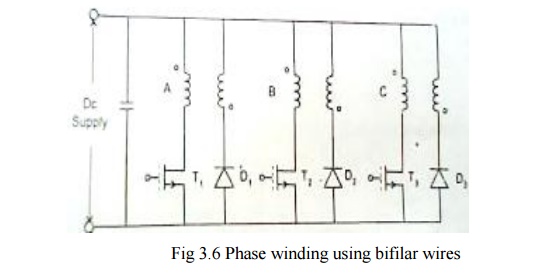
When T1 is turned on the dc current passes through the phase winding A. when the devices T1 is turned off the stored energy in the magnetic field is fed back to the dc source through the winding A‘ and D1 to the supply.
The three devices operate in a sequential way depending upon the signals obtained from the rotor position sensor and the chopping signals for PWM technique obtained from the controller.
Merits
v The converter uses lower number of switching devices thus reducing the cost on the converter.
v The converter allows fast demagnetization of phases during commutation.
Demerits
v Bifilar winding suffers from double number of connections.
v A poor utilization of copper.
v Freewheeling is not possible during chopping as the phases have -Vdc. this causes of higher ripples in current and torque during chopping.
v The imperfection in the coupling between the two winding causes voltage spikes during turn off.
4. Split – link circuit used with even phase number
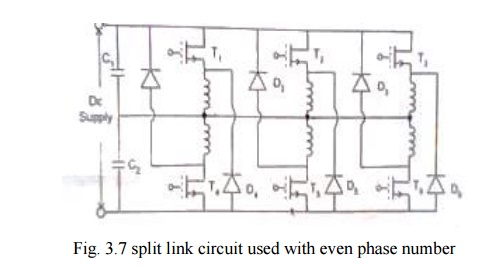
The circuit shown in fig.3.7 is used in a range of highly efficient drives (from 4-80kw).
The main power supply is split into two halves using split capacitors. During conduction, energy is supplied to the phases by one half the power supply. During commutation period, the phases demagnetize into other half of the power supply.
When switch T1 is turned on, phase winding 1 is energized by capacitor c1. When switch T2 is turned off, the stored energy in the phase winding 1 is fed back to the capacitor c2 through diode D4.
When T4 is turned on by capacitor C2 and phase winding 4 is energized. When switch T4 is turned off, stored energy in the winding 4 is feedback to the capacitor C1 through diode D1. The similar operation takes place in the remaining winding also.
Merits
v It requires lower number of switching devices.
v Faster demagnetization of phases during commutation.
Demerits
v During chopping, freewheeling is not possible as the phaser have the voltage Vdc/2. This causes higher switching frequency and more losses.
v This is not feasible for low voltage application.
5. C-Dump circuit
In the C dump circuit shown in fig. 3.8. the device count is reduced to ‗n‘ plus one additional devices to bleed the stored energy from the dump capacitor C back to supply via the step down chopper circuit. The mean capacitor voltage is maintained well above the supply to permit rapid defluxing after commutation.
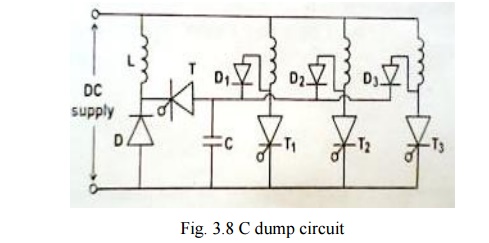
A control failure in the energy-recovery circuit would result in the rapid build-up of charge on the capacitor and if protective measures were not taken the entire converter could fail from over voltage.
Demerits
v Dump capacitor voltage is maintained ―2 Vdc‖ to allow fast demagnetization. But use of a capacitor and an inductor in the dump circuit and also the voltage rating of other devices is twice the bus voltage
v Monitoring of the dump capacitor voltage 'C‘ and control of dump switch T makes the converter very complicated and also the converter does not allow freewheeling.

